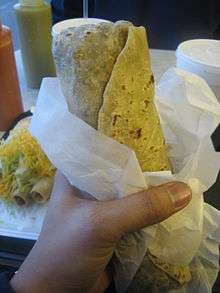Mexican cuisine
Understand
Ingredients
Some crops native to Mesoamerica, ubiquitous in Mexican cooking, are corn (maíz), tomatoes (tomato), avocado (aguacate), beans (frijoles) and cocoa. Beans and corn had nearly religious significance among some of the Precolumbian cultures and there is still hardly a food item without them. Other staples, such as rice (arroz), or wheat (trigo) have origins outside the Americas but have become integrated into Central American as well as Mexican cuisine
- Peppers — Mexican cuisine uses a great variety of peppers, from the innocuous to the extraordinarily spicy. Common types include red, green and yellow bell peppers, cascabel, cayenne, chilaca, chiltepin, guajillo, güero, habanero, jalapeño, poblano, and serrano, as well as preparations from these, such as chipotle (smoke-dried jalapeño) and ancho/mulato (ripened/unripened dried poblano).
- Tortillas — thin, soft flatbread made of a simple water-based dough of finely ground wheat or corn flour. They can be fried, baked, rolled or wrapped around ingredients, or simply served warm with butter or salsa. They are a staple of Mexican food, from simple peasant cuisine to high-end restaurants. Spikes in the price of tortillas can even lead to riots among poor Mexicans.
As Mexico is home to one of the widest varieties of cactus species, edible cacti and their fruits are also sometimes used as ingredients.
Mexican-American dishes
Several distinct variations of traditional Mexican cuisine originated in what is now the sourthwestern U.S., as traditional Mexican dishes adapted to local ingredients and U.S. influences. In many places, it is easier to find these dishes than the traditional foods of the Mexican heartland. Mexican dishes have also been adapted to international tastes, and are eaten all around the world--though these dishes often bear little resemblance to their traditional Mexican forebears.
- Tex-Mex — The most common version found outside of Mexico, it emphasizes ingredients such as shredded cheese and cumin not usually found in authentic Mexican cuisine, and includes unique tejano culinary creations such as chili con carne and fajitas. Although most Mexicans today wouldn't recognize most of these dishes as "Mexican" in any way, many Tex-Mex specialties originated in an era when Texas was controlled by either Spain or Mexico.
- Cal-Mex — California (the US state, as opposed to the Mexican Baja California) is another former Mexican territory with a pre-existing tradition that can be seen in its cuisine. Generally less cheesy than its Texan counterparts, it includes the uniquely large, aluminum-foil-wrapped "Mission-style" burrito.
- New Mexican food is a distinct cuisine, originating near Santa Fe--once the most distant northern outpost of Spanish and Mexican colonization. Spicy red and green chile sauces are its most notable feature--you'll often be asked whether you'd prefer "red or green" atop a dish of tamales or enchiladas. (You can order both by asking for "christmas"--a good way to test a restaurant's quality!) Many dishes are also influenced by the cooking of native Pueblo peoples.
Other popular fusions include Korean-Mexican dishes such as Korean tacos and bulgogi burritos, and Japanese takoraisu from Okinawa.
Popular dishes
Soups
- Menudo – Slow-cooked, spicy stew made from tripe (the stomach lining of a cow) and chilis.
- Pozole – Hominy (maize) and meat stew.
- Tortilla soup – A broth that includes strips of tortilla
Meat and poultry
- Adobo
- Alambre
- Barbacoa — Meats or whole sheep slow-roasted over an open flame, usually served with corn tortillas, plus guacamole and salsa.
- Cabrito — Roasted goat meat.
- Carne asada — Thin-cut marinated beef steak, often seared while cooking to impart a charred flavor. It can be served as a main dish or as a component of another, and is most common in the northern and western parts of Mexico.
- Chicharrones — Deep fried, crunchy, and very high-calorie pieces of pig skin.
- Chorizo — Mexican sausage, usually made from minced fatty pork with seasonings. It is somewhat different from its Spanish counterpart.
- Mole poblano – a dish originating in Puebla hence the name.
- Salpicon
- Tinga
Tortilla-based dishes

- Burritos — Literally meaning "little donkey" (from burro: donkey), they were allegedly named for the form that somewhat resemble donkey ears. Burritos are usually made of a flour tortilla and filled with meat and beans among other ingredients.
- Enchiladas – similar to burritos, only laid in a pan, topped with a sauce, and baked again.
- Chalupas – similar to a flat taco
- Flauta – usually a flour tortilla, rolled around a filling and deep-fried. A taquito is the same idea, but usually with a corn tortilla.
- Quesadillas
- Tacos
- Tostadas – like a chalupa, except usually with a fried flour tortilla as the base.
Other dishes
- Chile rellenos literally filled peppers
- Huevos rancheros
- Tamales
- Tortas
Tex-Mex dishes
- Chile con queso
.jpg)
- Chili con carne: While for the purist this only contains chili and meat (as the name says) beans and/or corn are often included in "internationalized" versions
- Chimichanga
- Fajitas
- Jalapeño poppers
- Nachos
- Sopapilla – Deep-fried pockets of pastry dough. Often served as dessert (in which case, honey or powdered sugar are common accompaniments), but it could also be stuffed with a savory filling.
Sides and sauces
- Frijoles charros
- Guacamole The most commonly known Mexican sauce. Always contains avocado
.jpg)
- Pico de gallo a mix of lime juice, tomato, onion and cilantro leaves. Can be added to almost anything. Comes in a spicy and a mild variant
- Red rice
- Refried beans
- Salsa ranchera
- Salsa taquera
- Tortilla chips